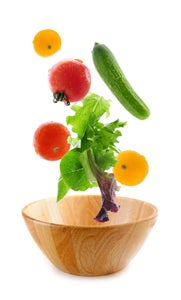Smart Snacking for Adults and Teens
 Make snacks work for you by choosing nutrient-rich foods from the grains, fruit, vegetable, dairy and protein food groups. Snacks can boost your energy between meals and supply essential vitamins and minerals. There is a place for snacks in a healthy eating plan. Just choose wisely:
Make snacks work for you by choosing nutrient-rich foods from the grains, fruit, vegetable, dairy and protein food groups. Snacks can boost your energy between meals and supply essential vitamins and minerals. There is a place for snacks in a healthy eating plan. Just choose wisely:
- Think of snacks as mini-meals that contribute nutrient-rich foods. You can fit snack calories into your personal healthy eating plan without over-spending your day's calorie budget.
- Snack only when you're hungry. Skip the urge to nibble when you're bored, frustrated or stressed. Feed the urge to do something by walking the dog or working in the garden.
- Keep portion control in mind. Have a single-serve container of yogurt or put a small serving of nuts in a bowl. Eating directly from a multiple-serving package can lead to overeating.
- Plan snacks ahead of time. Keep a variety of nutritious ready-to-eat supplies on hand, such as whole-grain crackers and low-fat cheese.
Get creative with the following snack suggestions by swapping out different fruits, vegetables and grains to keep your snacking exciting!
Snacks with 200 calories or less:
- One tablespoon peanut butter spread on slices of a medium apple
- One cup tomato soup with five whole-grain crackers
- Three cups air-popped popcorn sprinkled with three tablespoons grated parmesan cheese
- Tri-color veggie snack: 6 baby carrots, 10 sugar snap peas (or green pepper strips), 6 cherry tomatoes and 2 tablespoons reduced-fat ranch dressing for dipping
- Small baked potato topped with salsa and 1 ounce low-fat cheese
- Toaster waffle topped with ½ cup blueberries and 2 tablespoons low-fat yogurt
- Six whole-wheat crackers and one slice low-fat Colby cheese
- Fruit smoothie: Blend 1 cup fat-free milk, ½ cup frozen strawberries and ½ banana
- One 6-inch flour tortilla with ¼ cup black beans and 2 tablespoons fresh salsa
- Quick-to-fix salad: 2 cups mixed greens with ½ cup mandarin oranges, 1 tablespoon sliced almonds and 2 tablespoons reduced-fat dressing
- Mini-sandwich: Whole-grain dinner roll with 1 slice deli turkey, 1 slice low-fat cheese and mustard
Snacks with 200 to 300 calories for active adults, teens and athletes:
- Refuel between meals or after a work-out with these higher-calorie snacks. Watch serving sizes to stay within the range of 200 to 300 calories.
- Whole wheat pita cut into wedges with 2 tablespoons hummus for a dip
- Yogurt parfait: Layer 6 ounces fat-free yogurt, ½ cup berries and ¼ cup granola
- Trail mix: Mix 20 almonds, miniature box of raisins, and ¼ cup sunflower seeds
- Instant oatmeal made with fat-free milk with 1 tablespoon honey, ½ cup sliced peaches and dash of cinnamon
- One 4-ounce fat-free, ready-to-eat vanilla pudding with ½ cup fresh fruit and 5 vanilla wafers
- Veggie pizzas: Split whole wheat English muffin. Top with 2 tablespoons low-fat cream cheese, ½ cup diced fresh veggies and one ounce low-fat mozzarella cheese
- Cinnamon-raisin mini-bagel spread with one tablespoon peanut butter
- Hot chocolate made with low-fat or fat-free milk and a small oatmeal cookie
- Whole-grain toaster waffle with 1 ½ tablespoons chocolate-flavored hazelnut spread
- Banana split: banana sliced length-wise topped with ½ cup frozen yogurt and a tablespoon of chopped nuts
For more healthy eating tips, visit www.eatright.org.










